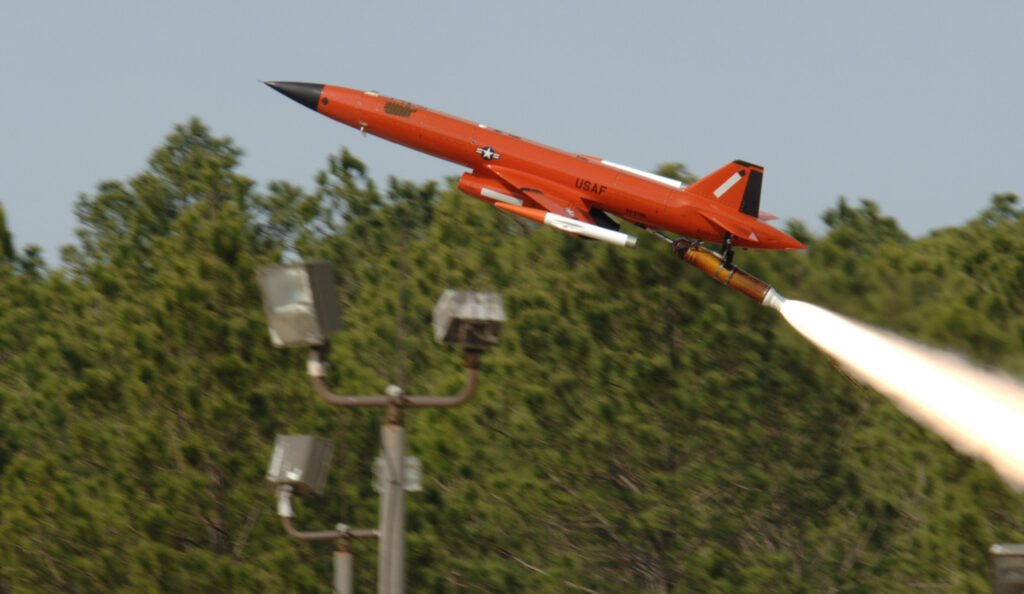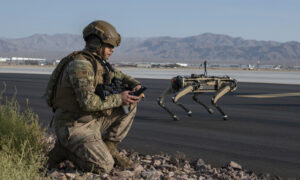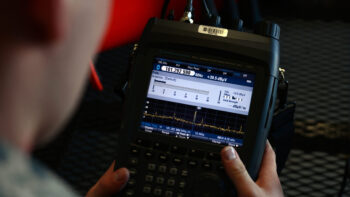
BQM-167 Air Force target drones served as surrogates for Russian cruise missiles during today’s ABMS on-ramp.WASHINGTON: The Air Force’s second demonstration of its burgeoning Advanced Battle Management System (ABMS) today included a series of ‘firsts’ — including enabling rapid detection and destruction of surrogate Russian cruise missiles by linking multiple sensors to multiple shooters in near real-time.
Perhaps most importantly, new Northern Command head Gen. Glen VanHerck told reporters this evening, the demo convinced him that artificial intelligence-driven software systems will be able to actually make recommendations that commanders can rely on to make decisions about what they need to do to prosecute a fast-paced battle with peer competitors China and Russia.
“I am not a skeptic after watching today,” he said.
Air Force acquisition czar Will Roper told reporters during the same briefing that one of the exercise’s big successes was the shoot-down by a novel hypervelocity projectile of one of the surrogate cruise missiles, played by BQM-167 target drones flying over White Sands Missile Range in New Mexico. The small projectile, which can fly at Mach 5, was developed by the Navy and the Army, he said, and was launched from an Army M109 Paladin-based 155mm howitzer and a Navy deck gun during the demo.
“Tanks shooting down cruise missiles is awesome — video game, sci-fi awesome,” Roper told a small group of reporters this evening.
He added that the hypervelocity weapon for missile defense was “near and dear to my heart,” because the development effort actually started under DoD’s Strategic Capabilities Office in 2013 when he was leading it.
Other shooters involved included the venerable AIM-9 air-to-air missile, launched by F-16 fighter jets and MQ-9 Reaper drones. But the AIM-9X also was lobbed for the first time from a ground system, one NORTHCOM officer told reporters yesterday at Andrews AFB. The command led scenario planning for the demo, that also include Space Command and Transportation Command, as well as all five services.
But the “star of the show,” Roper said, was the way data was used to enable the kill chain using both 4G and 5G networking and the cloud to produce a kill chain “that took seconds, not minutes.” He noted that there were some 60 different types of data feeds utilized in the demo.
VanHerck concurred that the information sharing aspects of the demo was key as far as operators are concerned.
“From my perspective, this is all about domain awareness,” he said. He said he was most impressed by the ability to share domain awareness data from all domains among Combatant Commanders “in a common place where that information can then be utilized by decision-makers from a strategic level all the way to the tactical level.”
While the first ABMS “on-ramp” held in December 2019 focused on proving capabilities to link sensors via machine code, this larger much more ambitious demo was focused squarely on the command and control (C2) element of a fight, according to the NORTHCOM briefers.
As Breaking D readers know, the goal of the multi-faceted ABMS effort is to develop the backbone connections required to build a military Internet of Things (IoT). That military IoT, in turn, would enable the US military’s future Joint All-Domain Command and Control (JADC2) network of networks to combine data from multiple sensors across all domains, create a common operational picture (COP) and allow commanders to choose and assign shooters to targets via direct machine-to-machine links, all in minutes, not the hours or days needed today.
The move to “bring direct action on board for the first time” in today’s on-ramp was “one of the key innovative leaps that’s happened since December,” one NORTHCOM officer said.
“We got a lot of feedback from the first one — ‘You keep saying JADC2, but so far you’ve been really only talking about JADSA, JAD situational awareness. So where’s the C2 in what you are doing? This isn’t any good to me if I can’t tie it into something that can direct action’,” he explained.
The officials explained that the problem ABMS is trying to solve is that the technology available to commanders today for “domain awareness, command control, and deterrence to defeat” of threats is outdated and incompatible.
In particular, sensors are stovepiped — one person sees one radar; another sees “blue force” tracking data, etc. — but nothing is integrated. Instead, “we play a 12-minute-long telephone game” with individuals calling each other. “And the only time that all of that data ever comes together is in the mind of the O-6 [the rank level of an Air Force colonel) at the command and control center who is making the decision,” one briefer said.
The scenario for the demo started with Russian action against US interests overseas, resulting in US force movements designed as deterrence measures. (“Things get sporty with Russia,” one participant quipped.)
The situation quickly escalated to include cyber attacks, then jamming and laser dazzling of US communications and imagery satellites. Finally, six ‘Russian’ conventional cruise missiles were launched against the homeland from the air and sea.
The action was scripted in four phases, one participant explained. The first focused on early indications and warnings, the phase during which the Intelligence Community usually leads the way. In phase 2, the focus was determining what “red” assets were doing — where the ‘Russian’ bombers and ships were moving for example — and figuring out their intent. The third phase concentrated on the surrogate cruise missile attacks — detecting them, identifying them as cruise missiles and not other aircraft in the area, tracking them and then engaging them.
Sensors ranged from the Raytheon-built AN/MPQ-64 Sentinel missile warning radar to novel acoustic and unattended ground-bases sensors, to new sensor towers (built by start-up Anduril Industries) that combined radar with electro-optical infrared cameras.
The ABMS program refers to the various products linking sensor data and finding targets to create of an all-domain COP for commanders “omniaONEs.” The ability to use AI/machine learning software systems to provide virtual reality-type battlefield awareness is at the heart of the ABMS effort, Roper said. He explained that there were five different products being evaluated for omniaONE use, all competing, but using standards developed by DoD to allow plug and play operations.

Advanced Battle Management System Overview
One example was the Lattice system provided by Anduril.
“What Lattice is focused on is sensor fusion command and control and distributed networking,” Chris Brose, former head defense staffer for Sen. John McCain and Anduril’s chief strategy officer, told me in a Zoom interview. “We don’t do robot dogs, or 5G,” he said with a laugh. “We do all the unsexy and necessary things related to data that actually enable the Joint Force to fight differently and better.”
Brose explained that Lattice is an “open and extensible software platform. So, I can bring sensor data of any different kind of modality from any different kind of deployed system into the software environment. I can employ machine learning and computer vision to process that information and fuze it to generate objects of interest — targets — and tracks of those targets.”
The last phase of the on-ramp focused on “blue” force ability to move forces around the country under the evolving concept of “agile combat employment.”
This involved using a number of new technologies to scramble a security convoy to protect Nellis AFB in Nevada — including the ability to track individual soldiers and sailors, according to the NORTHCOM officials. It also involved the “robot dogs” built by Ghost Robotics for perimeter defense that were supposed to be involved in the first ABMS but were unable to connect due to bandwidth issues. (The robot dog that reporters got a look at at Andrews was surprisingly realistic, complete with a fetching personality that practically begged to be petted.)
All of this computer processing, of course, takes serious bandwidth. And bandwidth, experts say, is one of the crucial challenges to JADC2 and a fully networked battlefield. Access to bandwidth is already a problem, and is bound to become more limited during combat due to enemy attacks on satellites and communications links, the NORTHCOM briefers explained.

Ghost Robotics Vision 60 prototype at Nellis AFB during the second ABMS on-ramp.
Thus, one of the main thrusts of the ABMS program is developing a secure cloud networking capacity for warfighters. ABMS has developed a strategic level cloud, “cloudONE,” and is working on a cloud at the tactical edge called “edgeONE.” The edgeONE application will allow data to be saved at the user’s end when connectivity to the central data cloud is lost, but automatically update once the connection was re-established, Roper explained.
Roper said one of the “good failures” during today’s on-ramp was the less than optimal connectivity among the four different national test ranges involved. “Things dropped out,” he said. “It was something we fought with all day.” One of the causes, he explained, was “weather challenges'” at some of the sites. These are problems, he said, that are indicative of likely real world issues that ABMS will need to handle.
He added that the demo also showed that the ability of AI assistant applications, such as DoD’s Project Maven, to generate “courses of action,” or COAs, for commanders to use in making decisions about actions is not yet ready for prime time.
“I think our COA generation tools generated by artificial intelligence and machine learning have more work to do,” Roper said. “I would not give it the check box.”
This was despite the fact that VanHerck and operators from four other Combatant Commands (and all of the services) were impressed, and would happily take that capability as it is today, Roper added.
Roper and VanHerck agreed that the ABMS “cloudONE” is one of the products ready to enter into the field. Roper said the acquisition method for transitioning ABMS tech to users would first be indefinite delivery/indefinite quantity (ID/IQ) contracts with vendors, but stressed that any decisions to buy products would be made by Combatant Commands.
“Certainly the ability to to utilize the cloud to share information is there and we need to move quickly and rapidly down that path,” VanHerck said. “I was very encouraged by the status, if you will, of those systems and capabilities. I think they can be brought online within a year or less.”
The next ABMS on-ramp is actually scheduled for two weeks from now, based on a Pacific Command scenario, Roper said. The short turn-around is due to the fact that today’s demo was delayed. The fourth demo, being planned for next year, will involve allies for the first time, he added.
Australia unveils ‘historic’ defense boost to 2.4% of GDP in decade, but critics say too little, too late
Part of the shakeup includes tens of billions for nuclear-powered subs, and halting the pricey procurement of an additional F-35 fighter jet squadron.



























